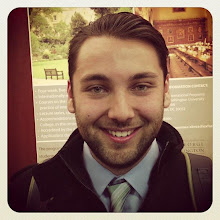This last weekend was my first study tour with DIS. Each core program has a short study tour and long study tour built into the curriculum. My class took our short tour to the Danish-Germans Border Region from Thursday to Saturday. My class is about cultural migration and identity with Europe, so we went to the border to learn about Danish minorities within Germany, and German minorities within Denmark. The border between these two nation-states has moved quite a bit over the years, so on each side of the border there are substantial portions of the population whose national identity does not correspond to where they live. This has caused some problems over the years, however now a lot is being done to promote cultural interaction, as well as to sustain these two small communities.
We started out in southern Denmark, in a town called Kolding. Here we visited a castle that was located on the historical border between Denmark and the Duchy of Schleswig. In the late middle ages, the county was officially part of the Kingdom of Denmark, but only because the Duke has pledge allegiance to the King of Denmark. This castle was built to remind the Duke that it was the king who had the power in the relationship.
Koldinghus Castle


A view of Kolding from the Castle Tower

Next, we drove to northern Germany, to the town of Schleswig (from which the Duchy gets its name.) We visited a Danish school called the A.P. Møller School. There is a whole system of Danish schools in Germany, which are funded by the Danish government, in order to provide the Danish community with a link to Denmark. Many believe that the Danish school system is superior to the German system, and for that reason, many parents choose to place their children in the Danish school system, instead of the German one. It is important to note that each person in this region is permitted to identify with either national community, and for that reason German parents can place their children in Danish schools. The German-Danish distinction is not based on race or ethnicity, or even necessarily language or culture. Each person much make a personal decision as to which nation they wish to identify with, and many chose a combination of the two.
The A.P. Møller School is a high school built about one year ago, and is probably the nicest high school I have ever seen. It was a donation from Arnold Mærsk Mc-Kinney Møller, the richest man in Denmark, and the heir to the Mærsk shipping company. The high school is rumored to have cost $100 Million US Dollars, and is designed by the same architectural firm that designed the Copenhagen Opera House (also a Mærsk donation). Here me met a scholar who has studied border regions in depth, and is also a social studies teacher at the school. He talked about the history of the region, as well as the issues regarding minority identity in border regions.
The Library

Assembly Hall

Schleswig Cathedral

From Schleswig, we made our way to Flensburg, Germany for the night. The next day we explored the town, and then got a lecture from another professor who is an historian and very well acquainted with the area.



He then took us to back to Denmark, to see Dybbøl Banke, the sight of the 1864 war between Denmark and Prussia that pushed the border to the north. We then went to in Sønderborg Denmark, where we had a night tour of the castle there, and then spent the night at a local hostel. The next day we had a lecture at the University of Southern Denmark about the socio-economic issues facing the Danish German Border Region. After that, we were on our way back to Copenhagen.
Overall, I would say it was a very good study tour. We learned a lot about history, politics, and culture of the border regions. We met some very interesting academics, and saw some amazing places. I actually was relieved to be back in Denmark, because linguistically I understand just a little more than I did when I was in Germany. Many of us found that we were actually starting to rely on our Danish skills when we were among German speakers. We also had to sort through Euros for the first time on this trip, as Denmark has not yet adopted the Euro. As a final thought, here is a picture of the breakfast we had in Flensburg Germany. We ate in a small café in the attic of a building just off the main walking street. It is owned by an elderly German woman and her husband, neither of whom spoke English or Danish. Nevertheless, between the students who spoke English, the professor who spoke Danish, and the bus-driver who spoke Swedish, we were all able to communicate and enjoy a wonderful meal together.











